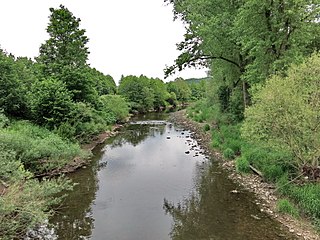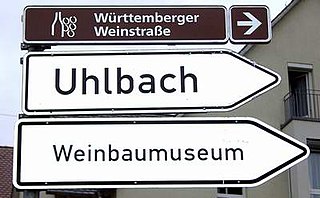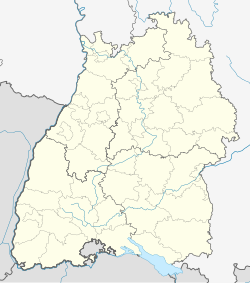
The Neckar is a 362-kilometre-long (225 mi) river in Germany, mainly flowing through the southwestern state of Baden-Württemberg, with a short section through Hesse. The Neckar is a major right tributary of the Rhine. Rising in the Schwarzwald-Baar-Kreis near Schwenningen in the Schwenninger Moos conservation area at a height of 706 m (2,316 ft) above sea level, it passes through Rottweil, Rottenburg am Neckar, Kilchberg, Tübingen, Wernau, Nürtingen, Plochingen, Esslingen, Stuttgart, Ludwigsburg, Marbach, Heilbronn and Heidelberg, before discharging on average 145 m3/s (5,100 cu ft/s) of water into the Rhine at Mannheim, at 95 m (312 ft) above sea level, making the Neckar its 4th largest tributary, and the 10th largest river in Germany. Since 1968, the Neckar has been navigable for cargo ships via 27 locks for about 200 kilometres (120 mi) upstream from Mannheim to the river port of Plochingen, at the confluence with the Fils.
Landkreis Heilbronn is a Landkreis (district) in the north of Baden-Württemberg, Germany. Neighboring districts are Neckar-Odenwald, Hohenlohe, Schwäbisch Hall, Rems-Murr, Ludwigsburg, Enz, Karlsruhe and Rhein-Neckar. In the centre of it is the free-city of Heilbronn, which is its own separate administrative area.
Landkreis Ludwigsburg is a Landkreis (district) in the middle of Baden-Württemberg, Germany. Neighboring districts are Heilbronn, Rems-Murr-Kreis, the district-free city Stuttgart, and the districts Böblingen and Enz-Kreis.

Heilbronn is a city in northern Baden-Württemberg, Germany, surrounded by Heilbronn District.

Neckarwestheim is a municipality with 3524 inhabitants in the Heilbronn district, Baden-Württemberg, in south-west Germany. It is located on the Neckar river and is well known as the location of a nuclear power station, the Neckarwestheim Nuclear Power Plant.

The Enz is a river flowing north from the Black Forest to the Neckar in Baden-Württemberg. It is 106 km long.

Affalterbach is a municipality in the Ludwigsburg district in Baden-Württemberg, Germany.

Bad Rappenau is a city municipality in the district of Heilbronn in Baden-Württemberg in southern Germany. It is situated about 15 kilometres (9 mi) northwest of Heilbronn.

Freiberg am Neckar is a town in the district of Ludwigsburg, Baden-Württemberg, Germany. It is situated on the left bank of the Neckar, 18 km north of Stuttgart, and 4 km north of Ludwigsburg.

Beilstein is a town in the district of Heilbronn in Baden-Württemberg in southern Germany. It is 14 kilometres (9 mi) southeast of Heilbronn. Beilstein is on the Württemberg wine route.

Murr is a municipality in the district of Ludwigsburg, Baden-Württemberg, Germany. It is situated on the river Murr, 2 km upstream from its confluence with the Neckar and about 9 km northeast of Ludwigsburg.

Ilsfeld is a municipality in the district of Heilbronn in Baden-Württemberg in Germany, on the outer edge of the Stuttgart Metropolitan Region. In addition to the village of Ilsfeld proper, it includes the formerly independent settlements of Auenstein and Schozach and some hamlets. Formerly predominantly agricultural, it has become more commercially oriented since an autobahn exit was built in the 1950s. The village of Ilsfeld was largely destroyed by a fire in 1904, and was rebuilt with public buildings in a rustic Württemberg style with Jugendstil elements.

Pfaffenhofen is a municipality in the district of Heilbronn in Baden-Württemberg in Germany.

Ingersheim is a municipality in the district of Ludwigsburg in Baden-Württemberg in Germany, belonging to the Stuttgart Region.

Oberstenfeld is a municipality in the district of Ludwigsburg in Baden-Württemberg in Germany. It is located about 40 km north of Stuttgart.
The Backnang–Ludwigsburg railway is a line on the northern edge of the Stuttgart region in the German state of Baden-Württemberg, linking Backnang and Ludwigsburg. The Backnang–Bietigheim line was opened in 1879 as a branch of the Murr Valley Railway from Waiblingen to Hessenthal and left the current route at Beihingen-Heutingsheim. The section between Beihingen-Heutingsheim and Bietigheim was damaged during the Second World War and was never returned to operation.

Marbach (Neckar) station serves the town of Marbach in the German state of Baden-Württemberg. It is the terminus for line S 4 of the Stuttgart S-Bahn and Regionalbahn trains from Backnang. Until 1966, this was the starting point of the Bottwar Valley Railway (Bottwartalbahn), which ran all the way to Heilbronn Süd station.

Besigheim station is located at line-kilometre 29.8 on the Franconia Railway (Frankenbahn) in Besigheim in the German state of Baden-Württemberg. According to the Railway Construction and Operating Regulations, it is considered to be a Haltepunkt, not a station.

Neckar-Zaber is an electoral constituency represented in the Bundestag. It elects one member via first-past-the-post voting. Under the current constituency numbering system, it is designated as constituency 266. It is located in northern Baden-Württemberg, comprising the southern part of the Landkreis Heilbronn district and the northern part of the Ludwigsburg district.

The Württemberger Weinstraße is a Holiday Route through the Wine Growing Area Württemberg that begins in Niederstetten-Oberstetten, via Weikersheim, Heilbronn, Ludwigsburg and Stuttgart to Metzingen. The southern end point of the Württemberger Wine Route is the Kressbronn wine growing exclave on Lake Constance.





















